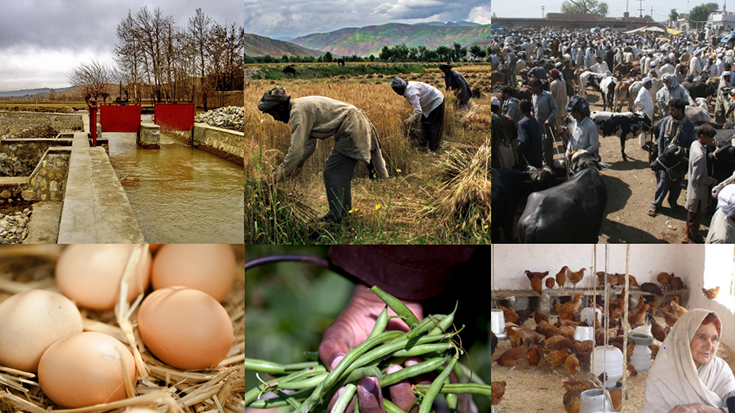More than 75% of Afghanistan’s population, and nearly 90% of those living in poverty, live in rural areas. With a 25% contribution to GDP and about half of all households receiving income from it, agriculture has great potential to be, along with mining and the services sectors, one of the main drivers of economic growth while reducing unemployment. Due to the country’s high population growth rate, agriculture will need to grow by at least 6% per year if rural incomes are to increase and population standards of living significantly improve. This is nearly twice as fast as its average growth rate over the past decade, and achieving it will be challenging and require game-changing policies and investments. However, this would be possible given that, fortunately, Afghanistan has many catch-up opportunities —from revamping rural institutions, to re-building infrastructure and updating technology, that greatly suffered during the years of conflict— that offer the possibility of faster agricultural growth.
In 2009, the National Agriculture Development Framework (NADF) was formulated; a comprehensive plan structured around agricultural production and productivity, economic regeneration, natural resource management and change management. However, its implementation, including enactment and enforcement of new policies, is proving to be challenging. Even once these are adopted, serious concerns will remain about the capacity to implement such a broad range of interventions within any realistic time frame, and whether the necessary financial resources will be available in an era of fiscal tightening. Thus, it would be more realistic to focus attention at this stage on a few “first movers”; specially, priority commodities that are imported as well as traditional export crops. Focused investing in those, to promote hard growth and increased job creation, will also serve as an example for the rest of the sector to follow.
A Selective Agricultural Strategy for Quicker Results
A selective agricultural strategy must take into account the diversity of Afghan Agriculture regarding the wide variety of very different production systems and large percentage of small farms –of less than 1 hectare– involved, and the uneven distribution of cropland and water among differently-sized farms. In this context, developing agriculture calls for a two-pillar strategy:
a) Pillar I : Prioritized Value Chains
Irrigated wheat and horticulture –fruits, nuts, and vegetables–, and intensive livestock in peri-urban areas –milk, eggs, and poultry meat– are the value chains that provide the most promising opportunities for “first movers”. Currently, these three sub-sectors account for 66 % of agricultural GDP. With the right mix of policies and strategic investments, the three subsectors could double the value of agricultural production and add 1.3 million Full Time Equivalent (FTE) jobs in 10 years. These three subsectors have several major advantages in that they:
- have the best catch-up potential for raising productivity in the short term, can be produced on a competitive basis with imports, and have strong and growing demand at home and abroad;
- are spatially concentrated in relatively small intensive irrigated and peri-urban areas that are somewhat secure and have good access to markets, with potential to leverage planned resource corridors infrastructure investments; and
- can leverage significant value addition and employment along value chains, and promote increased incomes, employment and food security for large numbers of people since they are concentrated in areas where the greatest numbers of poor people live.
The further development of these value chains underpinning this “first mover” strategy would counter opium poppy production and allow for the growth of the agro-industry, provided that there is a sound business environment that attracts investment. Other constraints that will need to be tackled include cross cutting issues such as the availability of water, lack of research and development, lack of extension services, lack of regulations of inputs which results in poorer quality, ambiguous land policies, the lack of rural credit, and the need to increase more women to participate in agriculture.
b) Pillar II : Addressing the Needs of the Rural Poor
Implementation of Pillar I investments and policies should yield widespread benefits for the poor. However, the poor who are least likely to gain are those who live in more remote rain-fed farming areas and those who are agro-pastoralists. Interventions to raise the productivity of rain-fed crops and extensive livestock systems (including the nomadic systems) may be a way to help this group of poor, and could offer widespread gains at relatively low cost.
Even so, the prospect for significant productivity gains in rain-fed and extensive farming systems is limited. Thus other complementary and non-farm interventions will also be required, especially for people with access to little land or livestock. These interventions include community development programs, relief programs in drought years, education and training, settlement programs for nomadic people, and social protection programs (e.g. targeted cash transfers, and cash and food for work). Except for community development programs, these options are not well developed in Afghanistan at present, and hence will need to be expanded.
To learn more, read the full report:
